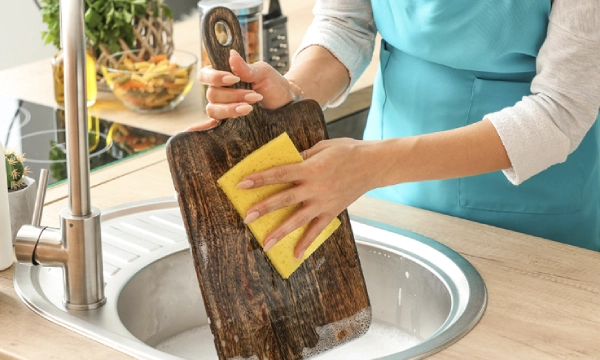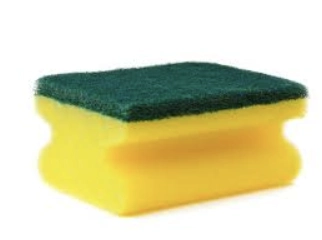Did you know that the kitchen is often the dirtiest place in a house? That’s because lots of things in there can be perfect homes for harmful germs like Salmonella, E. coli, Campylobacter, Shigella, and Listeria.
Surprisingly, in the United States alone, more than 48 million people get sick from eating contaminated food each year, according to the Centers for Disease Control and Prevention. It’s a big number, no matter where you live.
Why a Clean Kitchen Matters
Let’s start by talking about why it’s super important to keep your kitchen clean for your health. When your kitchen is clean, you’re less likely to get sick. Nobody wants to be sick, right?
II. The Sneaky Spots Where Bacteria Love to Hide
Now, let’s dive into the places where those sneaky bacteria love to hang out in your kitchen. They like to hide in these spots because they can cause trouble if they’re not cleaned properly:
1. Cutting Boards (Where You Chop Food):

These are the boards you use to chop veggies, meat, and other foods.
Bacteria can stick around after you’ve chopped something, especially if you don’t clean the board well.
2. Kitchen Sponges and Dishcloths (What You Use for Cleaning):

These are the spongy things and cloths you use to clean dishes and wipe counters.
They can get wet and stay damp, which bacteria love.
3. Fridge (Where You Keep Your Food):
Your fridge is where you store your groceries and leftovers.
If you have spilled food or forgotten items that go bad, it can become a bacteria playground.
4. Countertops and Things You Cook On:
These are the surfaces where you prepare and cook your meals.
If they aren’t cleaned well, bacteria from raw food can stick around and get on your cooked dishes.
5. Sink and Drain (Where You Wash Dishes):
The sink is where dirty dishes and utensils go before they’re cleaned.
Leftover food particles can attract bacteria in the drain.
6. Kitchen Gadgets (Like Blenders):
Appliances you use for cooking and blending can have nooks and crannies where bacteria hide.
If not cleaned properly, they can transfer germs to your food.
7. Your Hands and Utensils:
Your hands touch everything in the kitchen, and utensils are used for cooking and eating.
If you don’t wash your hands and utensils well, bacteria can spread.
Types of Bacteria Found
1. E. coli:
This one is called Escherichia coli (but you can call it E. coli).
It can make you really sick if you eat contaminated food.
Symptoms include stomach cramps, diarrhea, and sometimes more serious problems, especially in young kids and older adults.
2. Salmonella:
Salmonella is another troublemaker.
Eating food with Salmonella can lead to fever, diarrhea, and stomachaches.
It can be especially dangerous for people with weakened immune systems.
3. Listeria:
Listeria is a sneaky bacteria.
It can cause flu-like symptoms, but it can be super dangerous for pregnant women, newborns, and folks with weak immune systems.
In some cases, it can lead to severe infections, including meningitis.
4. Staphylococcus aureus:
This one has a fancy name, Staphylococcus aureus.
It can produce a toxin that makes you sick when you eat contaminated food.
Symptoms include vomiting, stomach cramps, and diarrhea.
5. Campylobacter:
Campylobacter is another stomach troublemaker.
It can cause fever, diarrhea, and stomach pain.
In some cases, it can lead to more serious complications.
For extra healthy air check out this air purifier guide.
Why You Should Care:
These bacteria can make you sick, and nobody wants that.
Symptoms can range from mild discomfort to serious illness, depending on the bacteria and your health.
So, it’s essential to keep your kitchen clean to prevent these germs from getting into your Maintaining a clean and bacteria-free kitchen is essential for your health. Here are some practical tips to help you keep your kitchen in top shape:
Kitchen Hygiene Tips for a Healthy Home
1. Proper Handwashing Techniques:
Wash your hands thoroughly with soap and warm water for at least 20 seconds before handling food.
Don’t forget to wash your hands after handling raw meat, poultry, or eggs.
Teach your family members, especially kids, the importance of handwashing.
2. Cleaning and Sanitizing Kitchen Surfaces:
Regularly clean countertops, cutting boards, and other food preparation surfaces with hot, soapy water.
Use a kitchen-safe disinfectant to sanitize surfaces, especially after handling raw meat.
Don’t forget doorknobs, handles, and switches, which can also harbor germs.
3. Storing and Handling Food Safely:
Keep raw meat, poultry, and seafood separate from other foods to prevent cross-contamination.
Use airtight containers to store leftovers in the refrigerator and label them with dates to track freshness.
Check expiration dates on food items regularly and toss anything past its prime.
4. Replacing Sponges and Dishcloths Regularly:
Sponges and dishcloths can become breeding grounds for bacteria.
Replace them every two to three weeks or when they start to look worn out.
Microwave damp sponges for 1-2 minutes to kill bacteria between replacements.
5. Cleaning Kitchen Appliances and Utensils:
Regularly clean and disinfect kitchen appliances, such as blenders and food processors, according to the manufacturer’s instructions.
Wash utensils like knives and cutting boards after each use.
Check for hidden crevices where bacteria can hide on appliances and utensils.
Specially clean your kitchens knifes
6. Managing Leftovers:
Refrigerate or freeze leftovers promptly to prevent spoilage and bacterial growth.
Reheat leftovers thoroughly until they reach a safe internal temperature (165°F or 74°C).
Use leftover food within a reasonable time to ensure its safety.
Conclusion
In this blog, we’ve explored the critical aspects of maintaining a clean and bacteria-free kitchen. Let’s recap the key points:
The Hidden Dangers: Bacteria love to hide in common kitchen spots like cutting boards, sponges, the fridge, countertops, and even your sink and utensils. Neglecting cleanliness in these areas can lead to health risks.
Troublemaker Bacteria: We’ve met some of the culprits, including E. coli, Salmonella, Listeria, Staphylococcus aureus, and Campylobacter. Each can cause a range of illnesses, from stomach discomfort to severe infections.
Best cleaning practices in the kitchen include:
- Proper handwashing is the foundation of kitchen hygiene.
- Regularly clean and sanitize kitchen surfaces.
- Handle and store food safely to prevent contamination.
